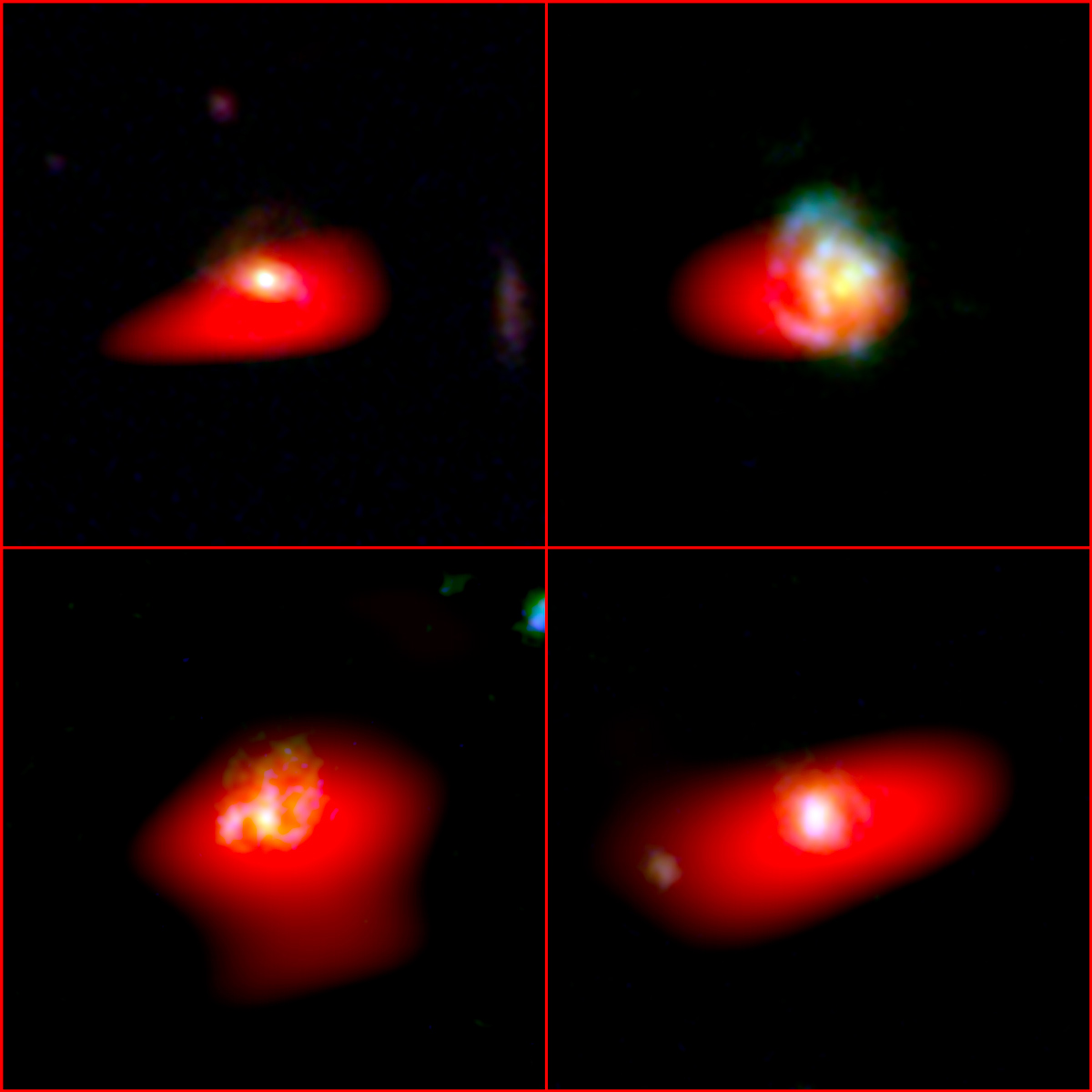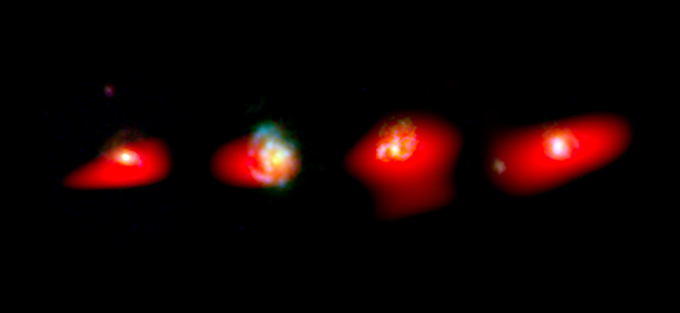Milky-Way-Like Galaxies Seen in their Awkward Adolescent Years
Spiral galaxies like our own Milky Way were not always the well-ordered, pinwheel-like structures we see in the universe today. Astronomers believe that about 8-10 billion years ago, progenitors of the Milky Way and similar spiral galaxies were smaller, less organized, but amazingly rich in star-forming material; so much so, that they would have been veritable star factories, churning out new stars faster than at any other point in their lifetimes.
Now, astronomers using the Atacama Large Millimeter/submillimeter Array (ALMA) have found evidence to support this view. By studying four very young versions of galaxies like the Milky Way as they were seen approximately 9 billion years ago, the astronomers discovered that each galaxy was incredibly rich in carbon monoxide gas, a well-known tracer of star-forming gas.
“We used ALMA to detect adolescent versions of the Milky Way and found that such galaxies do indeed have much higher amounts of molecular gas, which would fuel rapid star formation,” said Casey Papovich, an astronomer at Texas A&M University in College Station and lead author on a paper appearing in Nature Astronomy. “I liken these galaxies to an adolescent human who consumes prodigious amounts of food to fuel their own growth.”

Four Milky-Way-like progenitor galaxies (Top-left: ZFOURGE CDFS 467; Top-right: ZFOURGE CDFS 4409; Bottom-left: ZFOURGE CDFS; Bottom-right: ZFO,URGE CDFS 6497) as seen as they would have appeared 9 billion years ago. ALMA observations of carbon monoxide (red) is superimposed on images taken with the Hubble Space Telescope. The carbon monoxide would most likely be suffused throughout the young galaxies. Credit: ALMA (ESO/NAOJ/NRAO) C. Papovich; A. Angelich (NRAO/AUI/NSF); NASA/ESA Hubble Space Telescope. | Download image
Though the relative abundance of star-forming gas is extreme in these galaxies, they are not yet fully formed and rather small compared to the Milky Way as we see it today. The new ALMA data indicate that the vast majority of the mass in these galaxies is in cold molecular gas rather than in stars. These observations, the astronomers note, are helping build a complete picture of how matter in Milky-Way-size galaxies evolved and how our own galaxy formed.
Additional information
“Large molecular gas reservoirs in ancestors of Milky Way-mass galaxies nine billion years ago” Papovich et al. is published in Nature Astronomy’s Advance Online Publication.
The Atacama Large Millimeter/submillimeter Array (ALMA), an international astronomy facility, is a partnership of the European Organisation for Astronomical Research in the Southern Hemisphere (ESO), the U.S. National Science Foundation (NSF) and the National Institutes of Natural Sciences (NINS) of Japan in cooperation with the Republic of Chile. ALMA is funded by ESO on behalf of its Member States, by NSF in cooperation with the National Research Council of Canada (NRC) and the Ministry of Science and Technology (MOST) in Taiwan and by NINS in cooperation with the Academia Sinica (AS) in Taiwan and the Korea Astronomy and Space Science Institute (KASI).
ALMA construction and operations are led by ESO on behalf of its Member States; by the National Radio Astronomy Observatory (NRAO), managed by Associated Universities, Inc. (AUI), on behalf of North America; and by the National Astronomical Observatory of Japan (NAOJ) on behalf of East Asia. The Joint ALMA Observatory (JAO) provides the unified leadership and management of the construction, commissioning and operation of ALMA.
Contacts
-
Nicolás Lira
Education and Public Outreach OfficerJoint ALMA Observatory, Santiago - ChilePhone: +56 2 2467 6519Cel: +56 9 9445 7726Email: [email protected] -
Richard Hook
Public Information Officer, ESOGarching bei München, GermanyPhone: +49 89 3200 6655Cel: +49 151 1537 3591Email: [email protected] -
Charles E. Blue
Public Information OfficerNational Radio Astronomy Observatory Charlottesville, Virginia - USAPhone: +1 434 296 0314Cel: +1 202 236 6324Email: [email protected] -
Masaaki Hiramatsu
Education and Public Outreach Officer, NAOJ Chile

